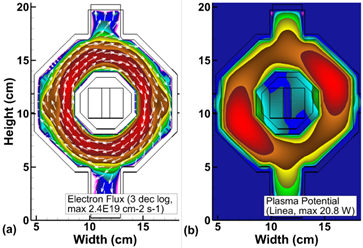The 4th state of matter, plasmas exist as a non-equilibrium soup of electrons, ions, neutral radicals, and molecular species. While often (ironically) hidden from view in everyday life, plasmas play a critical role in modern society, ranging: semiconductor manufacturing and material synthesis, plasma solution activation for medicine, plasma driven solution electrolysis for agriculture, carbon capture, and energy storage, plasma spacecraft propulsion, and nuclear fusion.
The Plasma Science Research Group (PSRG) at Aberdeen is an interdisciplinary group based in the Department of Physics, spanning the schools of Natural & Computing Science, Engineering, and Geoscience. Headed by Dr. Scott Doyle, the PSRG develops and employs state-of-the-art numerical modelling techniques to address fundamental and applied plasma physics problems relating to energy storage, plasma materials processing, plasma propulsion, and nuclear fusion. Collaboration with the Department of Chemistry and Chemical Processes & Materials group facilitates plasma source fabrication, experimental diagnosis, and industrial deployment.
Currently, the PSRG are investigating:
Plasma-Assisted Production of Green Hydrogen from Seawater
Plasma-Assisted 'In-Situ Resource Utilisation' of Lunar Water-Ice
Plasma Catalysis and Chemical Conversion of CO2 and H2O
Fundamental Plasma Interactions with Multi-Phase Surfaces
Multi-Harmonic & Magnetic Plasma Control Schemes
Plasma Surface Modification for Semiconductors
Wave-Coupled Plasma Propulsion Systems
Fusion-Edge Plasma Surface Interactions
Our Projects
- High-Volume Green Hydrogen Production from Seawater
- Plasma-Assisted In-Situ Resource Utilisation for Lunar Water-Ice Extraction and Purification
- Propellant Ambiguity for Radio-Frequency Plasma Micro-Propulsion (AMBI-RF)
- Electrocatalysis in non-thermal plasma for energy storage
- Wave-Coupled Plasma Propulsion Systems
- Electrified upgrading of biogas via plasma technologies








